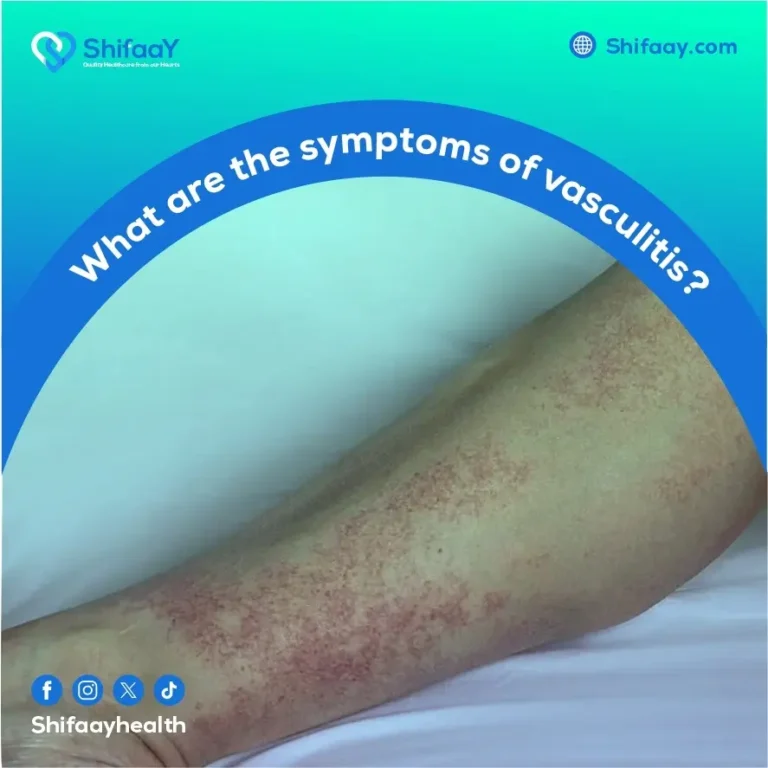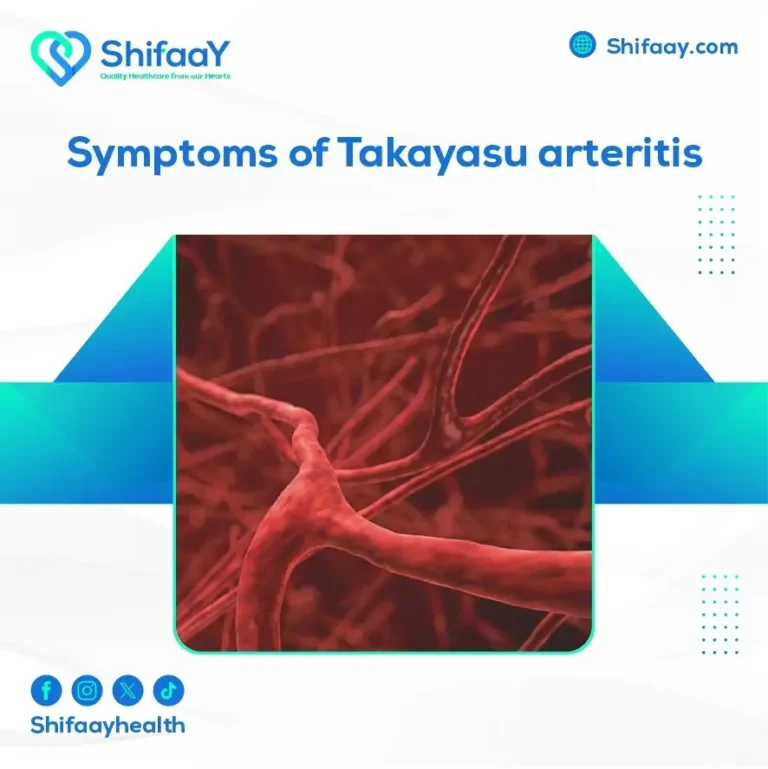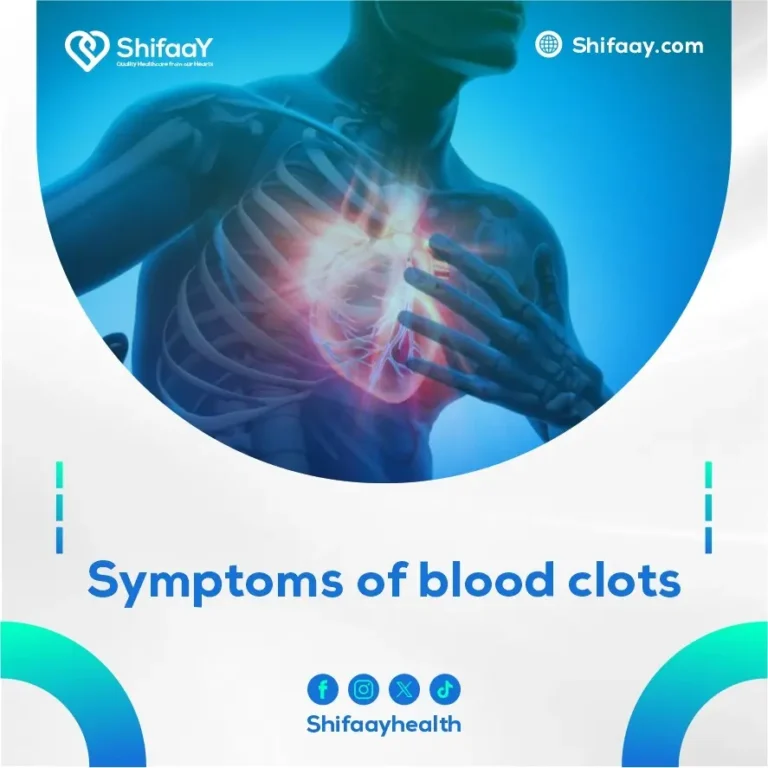Circulatory Disorders in the Legs
Circulatory disorders in the legs are common problems that affect people of various age groups. They are often caused by poor blood flow in the blood vessels due to blockages or narrowing of the arteries. Symptoms of this condition include a constant feeling of numbness, coldness, or pain, especially when walking or standing for long periods. If left untreated, it may develop into severe complications such as ulcers or gangrene. This is especially concerning for diabetic patients, the elderly, and individuals with high cholesterol or blood pressure. It serves as a warning sign of insufficient blood circulation that requires immediate medical intervention.
The importance of treating circulatory disorders in the legs lies in preventing the worsening of symptoms and improving quality of life. Treatment aims to restore normal blood flow and reduce the risk of blood clots or artery blockages. In some cases, treatment includes the use of vasodilator medications, anticoagulants, and lifestyle changes such as engaging in light physical exercises, quitting smoking, and following a balanced diet. In many advanced cases, a doctor may resort to surgical interventions such as catheterization or stent placement to improve blood flow in the legs.
Improving circulation in the lower limbs not only requires medical treatment for circulatory disorders in the legs but also necessitates regular monitoring of artery health through periodic ultrasound examinations or vascular mapping. Early detection of any abnormalities helps control the progression of the condition and reduces the likelihood of severe blockages or clots that can affect the patient’s overall health.
Weak Circulation in the Legs
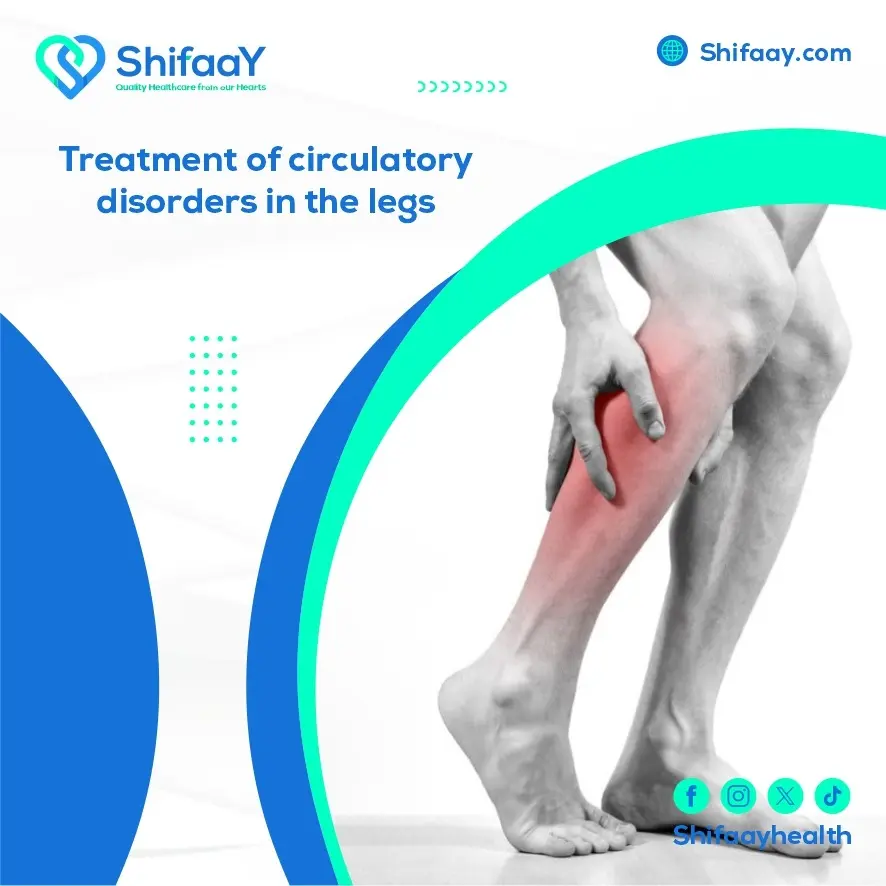
Weak circulation in the legs is a common health issue that many people experience without realizing the underlying cause of their symptoms. This weakness occurs when an insufficient amount of oxygenated blood and nutrients reach the lower limbs, resulting in sensations of numbness, tingling, or coldness in the legs. The danger of this condition is that it may be a sign of circulatory system disorders such as arteriosclerosis or heart diseases.
The primary causes of weak circulation in the legs include the buildup of fat and cholesterol inside blood vessel walls, which obstructs normal blood flow. Additionally, lack of movement and a sedentary lifestyle directly contribute to the worsening of the condition. Smoking, high blood pressure, and diabetes are also factors that increase the likelihood of circulatory disorders in the legs, as they negatively affect the efficiency of blood vessels and reduce their flexibility.
One of the warning signs of weak circulation is a constant feeling of heaviness in the legs, a change in skin color to blue or paleness, and the appearance of foot ulcers that are difficult to heal. In some cases, symptoms may not be noticeable until the condition has advanced, making early diagnosis essential to avoid complications. Therefore, it is important to pay attention to any changes in the legs, especially in the elderly or individuals with chronic diseases, and seek medical consultation immediately when symptoms arise.
Read aslo: Carotid Endarterectomy (CEA)
Causes of Poor Circulation in the Legs
Circulatory disorders in the legs are issues that directly affect comfort and movement, and they often result from a variety of factors, including health-related and behavioral causes. Poor blood flow to the legs can lead to symptoms such as numbness, coldness, swelling, or even constant pain. Therefore, it is important to understand the main causes to avoid worsening the condition.
First: Medical Causes of Poor Circulation in the Legs
There are several causes of poor circulation in the legs, often related to chronic health problems that affect blood vessels, the heart, or peripheral nerves. These causes are known as medical causes and require medical follow-up at a specialized center, such as Shifaay Healthcare Center, due to their direct impact on blood flow efficiency to the extremities. Below are the most common medical conditions that lead to circulatory disorders in the legs:
Arteriosclerosis (Atherosclerosis)
This occurs due to the accumulation of fat and cholesterol on the walls of the arteries, narrowing the blood passage and making it difficult for blood to reach the extremities. This condition is common with aging and directly impacts circulatory efficiency.
Varicose Veins
These result from a weakness in the veins’ valves responsible for returning blood from the legs to the heart. This dysfunction leads to blood pooling in the lower veins, causing swelling and chronic pain in the legs.
Diabetes
High blood sugar levels can damage small blood vessels, especially in the extremities, weakening blood flow and increasing the risk of chronic ulcers and infections in the feet.
Heart Failure or General Heart Issues
When the heart is unable to pump enough blood, the blood flow to the legs decreases, leading to sensations of coldness or weakness in the extremities due to insufficient blood supply.
Second: Non-Medical Causes of Poor Circulation in the Legs
Several factors are not directly related to diseases but contribute significantly to circulatory disorders in the legs. These often relate to daily lifestyle habits or negative behaviors. Below are some of these causes:
Sitting or Standing for Long Periods
Not moving the legs for extended periods leads to slow blood flow, causing feelings of numbness and heaviness, and increases the chances of fluid accumulation in the extremities.
Lack of Movement and Physical Activity
Continuous inactivity reduces the contraction of the leg muscles that help push blood towards the heart, leading to blood pooling in the lower extremities and poor circulation.
Smoking
Smoking negatively affects blood vessels, causing them to constrict. It also increases the risk of blood clots, which weakens blood flow and disrupts its natural movement to the legs.
Wearing Tight Clothing for Long Periods
Clothing that compresses the legs inhibits normal blood flow, especially when worn during sitting or long trips, leading to slow circulation.
Activating Blood Circulation in the Legs
The legs are among the parts of the body most affected by poor blood flow, especially for those who spend long periods sitting or standing without adequate movement. Therefore, they must understand that activating blood circulation in the legs is essential for maintaining tissue and muscle health and preventing the development of problems related to circulatory disorders in the legs, which can lead to swelling, numbness, or feelings of cold and tingling. There are many effective methods that help improve blood flow naturally without the need for medical interventions, which we will explain as follows:
Regular Daily Exercise
Light physical activities such as walking, cycling, or stretching exercises significantly contribute to stimulating blood circulation in the legs. These movements encourage the calf muscles to pump blood strongly toward the heart, reducing the risk of blood pooling in the extremities, which improves vascular health. These exercises also help reduce stress, which is an important factor in enhancing blood flow.
Massage and Warm Water Use
Regular massage using natural oils such as lavender or rosemary oil helps improve circulation and alleviate muscle tension. It is also recommended to use warm water on the legs, as it helps dilate blood vessels and increases blood flow to the tissues, thereby reducing symptoms of circulatory disorders in the legs.
Wearing Compression Socks
Wearing medical compression socks is also one of the important ways to improve blood flow in the veins of the legs, especially for those suffering from varicose veins or chronic swelling. These socks apply gradual pressure that helps significantly in returning blood to the heart, reducing the sensation of heaviness in the legs, especially after standing for long hours.
Raising the Legs During Rest or Sleep
Raising the legs on a pillow during rest or sleep for 15-20 minutes daily helps facilitate the return of blood to the heart. This method reduces swelling and lowers blood pressure in the veins of the legs, which directly enhances blood circulation.
Following a Vitamin-Rich Diet
Consuming foods rich in vitamin C and E and antioxidants helps strengthen blood vessels and improve blood flow. Drinking sufficient water helps maintain blood fluidity and prevents clotting, which is an essential factor in maintaining circulatory health.
Quitting Smoking and Reducing Caffeine Intake
Smoking is one of the causes of narrowing blood vessels and weakened circulation. Excessive caffeine intake can also cause temporary blood vessel constriction. Therefore, abstaining from these habits improves heart and vascular health and promotes blood circulation in the legs.
Symptoms of Poor Circulation in the Legs
Poor circulation in the legs is a health condition that significantly affects quality of life, leading to circulatory disorders in the legs and causing a lack of blood flow to nourish the tissues and organs in the lower limbs. Symptoms of poor circulation in the legs appear gradually and vary between clear physical signs that require early attention to avoid serious complications.
Numbness and Tingling
One of the most common symptoms of poor circulation in the legs is the sensation of tingling and numbness in the feet or legs. This happens due to inadequate blood supply to the peripheral nerves, affecting their ability to transmit signals normally. This numbness may be accompanied by a cold feeling, especially when resting or in cold environments, indicating circulatory disorders in the legs.
Swelling of the Legs and Ankles
Fluid accumulation in the tissues of the legs and ankles is a symptom of poor circulation that develops over time. This swelling is particularly noticeable after standing or sitting for long periods and results from poor blood return to the heart, leading to fluid retention in the lower extremities. It is sometimes accompanied by a feeling of heaviness and pain during walking or movement.
Skin Color Changes and Ulcers
Skin discoloration to blue or purple in the legs is a sign of poor circulation. This change is caused by a lack of oxygen reaching the tissues and may be accompanied by the appearance of ulcers and wounds that do not heal easily, especially in the foot and ankle area. These wounds indicate circulatory disorders in the legs and require ongoing medical monitoring.
Pain and Muscle Cramps While Walking
Pain accompanying walking or movement is a key symptom of poor circulation in the legs, known as “intermittent claudication.” This pain results from insufficient oxygen-rich blood reaching the calf muscles, causing them to tire and experience painful cramps that subside with rest and return when movement resumes.
Persistent Cold Sensation
Persistent cold in the feet is another symptom of poor circulation, as the legs’ temperature decreases due to reduced blood flow, which limits heat transmission to the tissues. This symptom indicates a circulatory issue in the legs and requires urgent medical evaluation to prevent the condition from worsening.
Conclusion
Therefore, we can say that these combined symptoms reflect the presence of circulatory disorders in the legs, which require early diagnosis and appropriate treatment to maintain limb health and prevent complications.
Treatment for Poor Circulation in the Legs
Poor circulation in the legs is a common health problem that affects blood flow to the lower extremities, causing pain, numbness, and constant fatigue. Circulatory disorders in the legs can also lead to serious complications such as venous thrombosis and ulcers. Therefore, the treatment for poor circulation in the legs requires understanding effective methods that help improve blood flow and enhance vascular health. Treatment relies on several medical and natural approaches aimed at reducing symptoms and improving quality of life. Below are several methods for treating poor circulation in the legs:
Vasodilator Medications
These medications work by expanding the arteries and veins, which increases blood flow, reduces congestion, and relieves inflammation in the blood vessels. They also help reduce swelling and pain caused by poor circulation.
Anticoagulants
Used to prevent blood clots from forming, which can block vessels and worsen circulatory disorders in the legs. These medications are essential in cases of deep vein thrombosis or a high risk of developing it.
Compression Stockings
These stockings help improve the return of blood from the legs to the heart by applying gradual pressure on the veins, reducing leg swelling, and preventing blood from pooling in the superficial veins.
Leg Strengthening Exercises and Walking
Regular physical activity, especially walking and exercises to strengthen the leg muscles, helps activate circulation and improve the function of the vein valves, alleviating symptoms related to poor circulation.
Elevating the Legs During Rest
Raising the legs above the level of the heart reduces blood pooling in the veins and alleviates pressure on them, improving circulation and reducing swelling and pain.
Lymphatic Massage
This type of massage helps stimulate blood flow and lymphatic fluid, relieving tissue congestion, promoting cell renewal, and reducing the feeling of heaviness and fatigue in the legs.
Surgical Intervention
In severe cases that do not respond to conventional treatments, the doctor may resort to surgical procedures such as removing blockages or expanding the arteries to directly improve blood flow.
Adopting these methods in a comprehensive manner helps improve the treatment of poor circulation in the legs and reduces the impact of circulatory disorders in the legs on overall health.
The Difference Between Poor Circulation and Arteriosclerosis
Poor circulation and arteriosclerosis are health issues that significantly impact the health of blood vessels and blood flow, especially in the extremities such as the legs. Circulatory disorders in the legs can cause troublesome symptoms that require precise medical attention. Poor circulation refers to the reduced efficiency of blood flow through blood vessels, which leads to a lack of oxygen and nutrients reaching the tissues, while arteriosclerosis is a condition where the walls of the arteries harden due to the accumulation of fats and cholesterol, narrowing the arteries and limiting normal blood flow. To compare poor circulation with arteriosclerosis, the following points can be clarified:
Causes: Poor circulation often results from multiple factors such as prolonged sitting, muscle weakness, or vein problems, while arteriosclerosis occurs due to the buildup of fatty plaques inside the arteries, making them less flexible and obstructing blood flow.
Symptoms: In poor circulation, symptoms such as cold extremities, numbness, and fatigue in the legs, along with possible swelling and pain, appear. In contrast, arteriosclerosis causes severe and recurrent pain in the legs, especially when walking, along with skin discoloration and difficulty healing wounds due to reduced blood flow.
Treatment and Prevention: Poor circulation can be improved through exercise, lifestyle changes, and stimulating blood flow, while arteriosclerosis requires more complex medical intervention, including medications that reduce fat buildup, strict lifestyle changes, and in some cases, advanced medical procedures.
Therefore, understanding the difference between poor circulation and arteriosclerosis helps in accurately diagnosing the condition and selecting the appropriate treatment to avoid complications from circulatory disorders in the legs.
Exercises to Activate Blood Circulation in the Legs
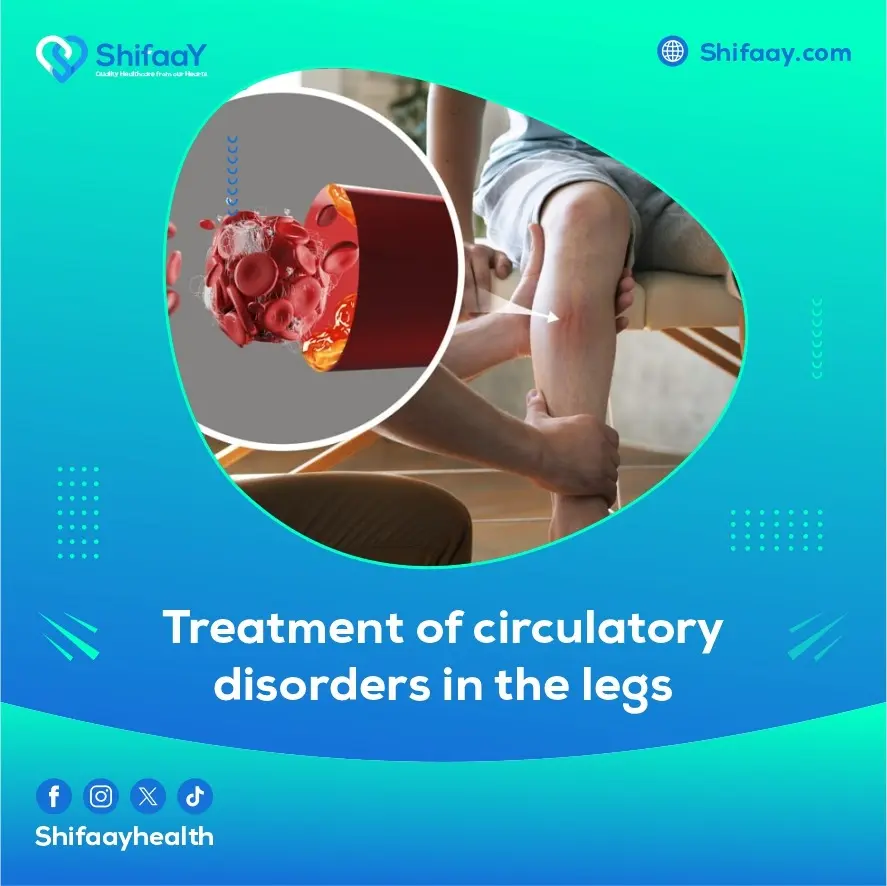
One of the most important steps to improve blood flow and reduce the risk of circulatory disorders in the legs, such as swelling, heaviness, and muscle cramps, is following exercises to activate blood circulation in the legs. These exercises significantly help enhance blood movement from the veins to the heart, reducing the chances of blood clots and improving vascular health, especially for those who spend long hours sitting or standing. The circulation is negatively affected due to insufficient leg movement. Below, we will explain the most important exercises that you can perform under the supervision of one of the doctors at Shifaay Healthcare Center, which is considered the best medical tourism company in Egypt:
Leg Raise Exercise
Lie on your back and slowly raise your leg until it reaches a 45-degree angle. Hold it for a few seconds, then lower it slowly and repeat with the other leg. This exercise helps facilitate blood flow from the legs to the heart and reduces pressure on the veins, preventing blood pooling and alleviating symptoms of circulatory disorders in the legs.
Walking Exercise
Make sure to walk at a moderate pace for 15-30 minutes daily, either outdoors or indoors. Walking stimulates the calf muscles to contract and relax, enhancing blood circulation and reducing vein congestion, which in turn alleviates swelling and heaviness in the legs.
Knee Flexion with Rotation
Sit and lift your feet off the ground, then slowly move your ankles in circles 10 times in each direction. This exercise greatly helps improve joint flexibility and activate blood circulation in small blood vessels, reducing cramps and alleviating the feeling of heaviness.
Walking on Tiptoes
You can try walking on your tiptoes for 1-2 minutes while maintaining balance. With regular practice, you’ll find that it activates the calf and foot muscles, enhances blood pumping, improves vein movement, and reduces circulatory disorders.
Heel Press Exercise
You can perform this exercise by standing upright and slowly lifting your heels off the ground until you are standing on the tips of your toes. Then, slowly lower them and repeat 15-20 times. This exercise significantly helps activate the lower leg muscles and stimulates blood flow to the heart, reducing swelling and pain caused by circulatory disorders in the legs.
For those seeking treatment for circulatory disorders in the feet, regular performance of these exercises, along with deep breathing, helps improve leg health and avoid complications related to poor circulation.
How Can Blood Circulation in the Legs Be Improved?
Blood circulation in the legs can be improved by exercising regularly, such as walking and stretching, raising the legs to facilitate the return of blood to the heart, and avoiding sitting or standing for long periods. Wearing compression stockings and consuming a healthy diet rich in vitamins also helps enhance blood flow and strengthen blood vessels.
What Are the Causes of Poor Circulation in the Legs?
Poor circulation in the legs can result from several causes, such as aging, lack of physical activity, obesity, diabetes, high blood pressure, smoking, and cardiovascular diseases. Blood clots or vein inflammation can also cause poor blood flow to the legs.
Is Poor Circulation in the Legs Dangerous?
Poor circulation in the legs can be dangerous if left untreated because it can lead to swelling, pain, skin ulcers, and even blood clots that may cause serious health complications. Therefore, it is important to consult a doctor as soon as symptoms appear to improve the condition and prevent it from developing into more severe health problems.



